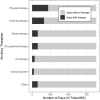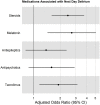Delirium in Children Undergoing Hematopoietic Cell Transplantation: A Multi-Institutional Point Prevalence Study
- PMID: 33968727
- PMCID: PMC8100670
- DOI: 10.3389/fonc.2021.627726
Delirium in Children Undergoing Hematopoietic Cell Transplantation: A Multi-Institutional Point Prevalence Study
Abstract
Introduction: Delirium occurs frequently in adults undergoing hematopoietic cell transplantation, with significant associated morbidity. Little is known about the burden of delirium in children in the peri-transplant period. This study was designed to determine delirium rates, define risk factors (demographic and treatment related), and establish feasibility of multi-institutional bedside screening for delirium in children undergoing hematopoietic cell transplant. Methods: This is a multi-institutional point prevalence study. All subjects were prospectively screened for delirium twice daily using the Cornell Assessment of Pediatric Delirium over a 10-day period. De-identified data, including basic demographics and daily characteristics, were extracted from the electronic medical record. Results: Eleven North American institutions were included, 106 children were enrolled, and 883 hospital days were captured. Delirium screening was successfully completed on more than 98% of the study days. Forty-eight children (45%) developed delirium over the course of the 10-day study. Children were diagnosed with delirium on 161/883 study days, for an overall delirium rate of 18% per day. Higher delirium rates were noted in children <5 years old (aOR 0.41 for children over 5 years), and in association with specific medications (melatonin, steroids, and tacrolimus). Conclusion: Delirium was a frequent occurrence in our study cohort, with identifiable risk factors. Delirium screening is highly feasible in the pediatric hematopoietic cell transplant patient population. A large-scale prospective longitudinal study following children throughout their transplant course is urgently needed to fully describe the epidemiology of pediatric delirium, explore the effects of delirium on patient outcomes, and establish guidelines to prevent and treat delirium in the peri-transplant period.
Keywords: cancer; cornell assessment of pediatric delirium; delirium; hematopoietic cell transplant; incidence; pediatric oncology; risk factors.
Copyright © 2021 Traube, Gerber, Mauer, Small, Broglie, Chopra, Duncan, Ebens, Fitzgerald, Freedman, Hudspeth, Hurley, Mahadeo, McArthur, Shapiro, Sharron, Wall, Zinter, Greenwald, Silver and Boulad.
Conflict of interest statement
The authors declare that the research was conducted in the absence of any commercial or financial relationships that could be construed as a potential conflict of interest.
Figures




References
-
- American Psychiatric Association . Diagnostic and Statistical Manual of Mental Disorders. 5th ed. Arlington, VA: American Psychiatric Association; (2013). 10.1176/appi.books.9780890425596 - DOI
Grants and funding
LinkOut - more resources
Full Text Sources
Medical

